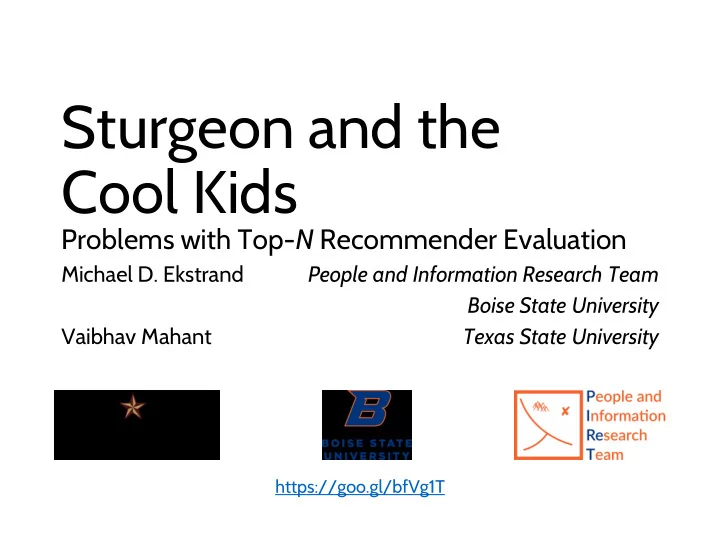

Sturgeon and the Cool Kids Problems with Top- N Recommender Evaluation Michael D. Ekstrand People and Information Research Team Boise State University Vaibhav Mahant Texas State University https://goo.gl/bfVg1T
What can editorials in mid-20th- century sci-fi mags tell us about evaluating recommender systems?
Evaluating Recommenders Recommenders find items for users . Evaluated: • Online , by measuring actual user response • Offline , by using existing data sets • Prediction accuracy with rating data (RMSE) • Top- N accuracy with ratings, purchases, clicks, etc. (IR metrics – MAP, MRR, P/R, AUC, nDCG)
Offline Evaluation Purchase / Train Data Rating Data Recommender Test Data Compare Recommendations & Measure
The Candidate Set Candidate set 𝐷 𝑣 Decoy set 𝐸 𝑣 Test set 𝑈 𝑣 Often: 𝐷 𝑣 = 𝐽 ∖ 𝑆 𝑣 (all items not rated in training) Recommender is a classifier separating relevant items ( 𝑈 𝑣 ) Recommmend from decoy items ( 𝐸 𝑣 )
Missing Data ☐ Zootopia IR metrics assume a fully coded corpus ☑ The Iron Giant • Real data has unknowns ☑ Frozen • Unknown = irrelevant ☒ Seven ☐ Tangled For recommender systems, this assumption is 👗🔦 RR = 0.5 AP = 0.417
Misclassified Decoys ☐ Zootopia 3 possibilities for Zootopia : ☑ The Iron Giant • I don’t like it ☑ Frozen • I do but data doesn’t know ☒ Seven • I do but I don’t know yet ☐ Tangled RR = 0.5 AP = 0.417
Misclassified Decoys If I would like Zootopia But have not yet seen it Then it is likely a very good recommendation But the recommender is penalized How can we fix this?
IR Solutions Rank Effectiveness • Only rank test items, don’t pick from big set • Requires ratings or negative samples Pooling • Requires judges – doesn’t work for recsys Relevance Inference • Reduces to the recommendation problem • Can we really use a recommender to evaluate a recommender?
Sturgeon’s Law Ninety percent of everything is crud. — T. Sturgeon (1958) Only 1% is ‘really good’ — P. S. Miller (1960)
Sturgeon’s Decoys Most items are not relevant. Corollary: a randomly-selected item is probably not relevant.
Random Decoys • Generalization of One-Plus-Random protocol (Cremonesi et al. 2008) • Candidate set contains • Test items • Randomly selected decoy items One Plus Random tries to recommend each test item separately
How Many Decoys? Koren (2008): right # is open problem, used 1000 Our origin story: find a good number or fraction
Modeling Goodness Starting point: Pr[𝑗 ∈ 𝐻 𝑣 ] , probability 𝑗 is good for 𝑣 goodness rate Want: Pr[𝐸 𝑣 ∩ 𝐻 𝑣 = ∅] ≥ 1 − 𝛽 high likelihood of no misclassified decoys Simplifying assumption: goodness is independent Pr[𝑗 ∉ 𝐻 𝑣 ] = 1 − 𝑂 Pr 𝐸 𝑣 ∩ 𝐻 𝑣 = ∅ = ෑ 𝑗∈𝐸 𝑣
What’s the damage? For 𝛽 = 0.05 (95% certainty), 𝑂 = 1000 1 1 − = 0.95 𝑂 = 0.0001 Only 1 in 10,000 can be relevant! MovieLens users like 10s to 100s of 25K films
Why so serious? If there is even one good item in the decoy set … … then it is the recommender’s job to find that item If no unknown items are good, why recommend?
Popularity Bias Evaluation naively favors popular recommendations Why? Popular items are more likely to be rated And therefore more likely to be ‘right’ Problem: how much of this is ‘real’?
Sturgeon and Popularity Random items are … … less likely to be relevant (we hoped) … less likely to be popular Result: popularity is even more likely to separate test items from decoys oops
Empirical Results
Empirical Findings • Didn’t see theoretically -expected impact • Absolute difference depends on decoy set size • Statistical significance depends on set size! • No clear inflection points for choosing a size • Algorithm ordering unaffected
Takeaways Random decoys seem useful, but … … have unquantified benefit … may not achieve benefit … have complex problems … hurt reproducibility
Future Work • Compare under Bellogin’s techniques • What happens w/ decoy sizes when neutralizing popularity bias? • Try with more domains • Try one-class classifier techniques • Extend theoretical analysis to ‘Personalized Sturgeon’s Law’
Thank you • Thanks to Sole Pera and the PIReTs • Texas State for supporting initial work Questions? https://goo.gl/bfVg1T
Recommend
More recommend